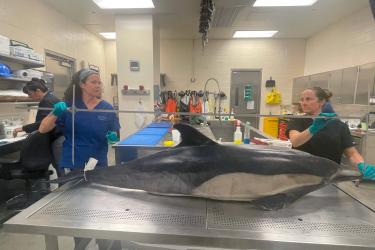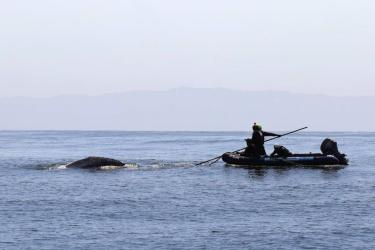Four wild steelhead populations in Washington State’s Olympic Peninsula have declined on average by more than half since the 1950s. These findings were published in a new paper in the North American Journal of Fisheries Management.
The paper’s authors also confirm that the Olympic Penninsula’s wild steelhead now return to freshwater an average of 1 to 2 months later than they did 70 years ago. The period from the beginning to the end of the run is shorter. Researchers on the paper included:
- Wild Salmon Center
- Trout Unlimited
- NOAA’s Northwest Fisheries Science Center
“In the 1950s, between a quarter to nearly one-half of Peninsula steelhead returned in November and December,” says lead author Matt Sloat of Wild Salmon Center. “Now January is considered by many to be the start of the wild steelhead season.”
Evidence suggests that these runs aren’t simply shifting later; instead, they seem to have lost their leaders. Aided by newly discovered historical data, the study’s authors determined that steelhead runs have largely lost these early returners. This loss is likely connected to declining abundance, notes Sloat.
“Run timing influences the opportunity for fish to access different habitats within a watershed. The loss of earlier returning fish means that the remaining population has fewer options for using the available habitat. As a result, overall steelhead production suffers,” says Sloat.
Various Factors Driving Changes
Why have numbers been dropping and run timing changing? It’s complicated. The paper investigates whether earlier-returning steelhead favor different spawning habitat than later-returning steelhead. It considers whether the earlier run, as a result, has lost more of that habitat over the last 70 years to land use practices like logging. Another set of questions concern hatcheries.
According to the paper, hatcheries might impact wild fish directly, through competition for resources—but also indirectly. Hatchery steelhead are bred to return to freshwater at times that overlap with earlier-returning wild steelhead. This increases the risk of accidental harvest of wild fish by mixed-stock fisheries. If true, these scenarios could mean that the gradual loss of earlier-returning wild steelhead is, at least in part, a result of overharvesting.
Historical Records Help Create A New Baseline
When it comes to steelhead, long-term insights like these have been hard to come by. That’s because management agencies often lack the historical data needed to see the big picture. As a result, fisheries managers often rely on contemporary fish counts to decide everything from goals for fish reaching the spawning grounds to emergency regulations. That narrow lens means we might be slow to recognize just how far these wild fish populations have declined.
Much of the data the new report hinges on spans the period of about 1948 to 1960, with additional earlier records unearthed, analyzed, and added to the contextual tapestry. For example, a single dusty, forgotten ledger in an Olympia office helped backfill daily fish count records to as early as 1948. This was decades before many steelhead population data even starts.
“Creating comparable data from these disparate historical records takes time and understanding,” says Martin Leirmann of NOAA’s Northwest Fisheries Science Center. “But it helps us avoid a shifting baseline, which is what happens when we only look at contemporary records.”
These records helped the study’s authors determine that 70 years ago, Olympic Peninsula steelhead populations were more than double the size of today’s runs.
“Extending the dataset is important because it provides a longer term context. For example, until recently, wild steelhead on the Olympic Peninsula have long been considered healthy and relatively robust compared to many other regions. We now know that not only are many contemporary populations in decline, but that they supported far more steelhead than we previously thought,” says co-author John McMillan of Trout Unlimited.
Rebuilding Life History Diversity Can Help
Although historical data implies the populations are in longer-term decline, results also suggest ways to help the populations. For example, rebuilding early returning life histories could increase diversity and help spread risk across a greater range of adults.
Improving diversity helps increase the portfolio of steelhead life histories. This can increase population stability and resilience. Greater diversity also means more steelhead in the river over a longer time.
The change in management perspective can’t come too soon for Peninsula steelhead. “We need all hands on deck to set coastal steelhead on a recovery path,” Sloat says. “Rebuilding won’t be easy, but our study provides a glimpse of what recovery could look like—diverse and abundant wild Peninsula steelhead runs.”



